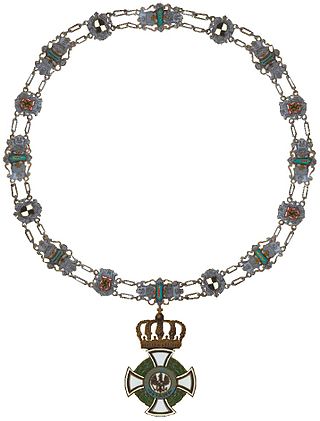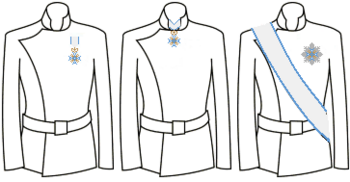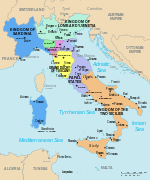
The Duchy of Modena and Reggio was an Italian state created in 1452 located in Northwestern Italy, in the present day region of Emilia-Romagna. It was ruled since its establishment by the noble House of Este, and since 1814 by the Austria-Este branch of the family. The Este dynasty was a great sponsor of the arts, making the Duchy a cultural reference during the Renaissance and Baroque periods.

Francis V, Duke of Modena, Reggio and Guastalla, Archduke of Austria-Este, Royal Prince of Hungary and Bohemia, Duke of Mirandola and of Massa, Prince of Carrara was a reigning prince. He was Duke of Modena, Reggio, and Mirandola, Duke of Guastalla from 1847 and Duke of Massa and Prince of Carrara from 1846 to 1859. His parents were Francis IV of Modena and Princess Maria Beatrice of Savoy. He was the last reigning Duke of Modena before the duchy was incorporated into the Kingdom of Italy.

Louis III, Grand Duke of Hesse and by Rhine was Grand Duke of Hesse and by Rhine from 1848 until his death in 1877.

The Order of Saints Maurice and Lazarus is a Roman Catholic dynastic order of knighthood bestowed by the royal House of Savoy. It is the second-oldest order of knighthood in the world, tracing its lineage to AD 1098, and it is one of the rare orders of knighthood recognized by papal bull, in this case by Pope Gregory XIII. In that bull, Pope Gregory XIII bestowed upon Emmanuel Philibert, Duke of Savoy and his Savoy successors, the right to confer this knighthood in perpetuity. The Grand Master is, Vittorio Emanuele, Prince of Naples, also known as the Duke of Savoy, the eldest son of the last King of Italy, Umberto II of Italy. However Vittorio Emanuele's cousin once removed Prince Aimone, Duke of Aosta claims to be grand master as his father claimed to be head of the house of Savoy.

The Imperial Order of Saint Stanislaus, also spelled Stanislas or Stanislav, is a Russian dynastic order of knighthood founded as Order of the Knights of Saint Stanislaus, Bishop and Martyr in 1765 by King Stanisław II Augustus of the Polish–Lithuanian Commonwealth. In 1831 after the downfall of the November Uprising, the order was incorporated into the Chapter of Russian Orders as part of the honours system of the Russian Empire by Emperor Nicholas I of Russia.

The House Order of Hohenzollern was a dynastic order of knighthood of the House of Hohenzollern awarded to military commissioned officers and civilians of comparable status. Associated with the various versions of the order were crosses and medals which could be awarded to lower-ranking soldiers and civilians.

Pontifical Equestrian Order of Saint Sylvester Pope and Martyr, sometimes referred to as the Sylvestrine Order, or the Pontifical Order of Pope Saint Sylvester, is one of five orders of knighthood awarded directly by the Pope as Supreme Pontiff and head of the Catholic Church and as the Head of State of Vatican City. It is intended to honor Catholic lay people who are actively involved in the life of the church, particularly as it is exemplified in the exercise of their professional duties and mastership of the different arts.

William, Prince of Hohenzollern was the eldest son of Leopold, Prince of Hohenzollern and Infanta Antónia of Portugal.

The Order of the Crown of Westphalia was instituted in Paris on 25 December 1809 by King Hieronymus I of Westphalen, better known as Napoleon's brother Jérôme Bonaparte. The motto of the Order was "CHARACTER UND AUFRICHTIGKEIT". At the back stood the words "ERRICHTET DEN XXV DEZEMBER MDCCCIX".

Rudolf Graf Montecuccoli degli Erri was chief of the Austro-Hungarian Navy from 1904 to 1913 and largely responsible for the modernization of the fleet before the First World War.
The Civil Order of Savoy was founded as an order of knighthood in 1831 by the King of Sardinia, Charles Albert, Duke of Savoy. It is now replaced by the Order of Merit of Savoy.The intention was to reward those virtues not belonging to the existing Military Order of Savoy, founded by Vittorio Emanuele I in 1815. The order has one degree, that of Knight, and is limited to 70 members. Admission is in the personal gift of the head of the House of Savoy.

The Military Order of Savoy was a military honorary order of the Kingdom of Sardinia first, and of the Kingdom of Italy later. Following the abolition of the Italian monarchy, the order became the Military Order of Italy.
Contardo of Este was the posthumous son of Aldobrandino I of Este, marquis of Ferrara. He was born in 1216 in Ferrara.

The Order of San Marino or Civil and Military Equestrian Order of Saint Marinus is an Order of Merit of San Marino. Established 13 August 1859, the order is presented for outstanding civil or military services to the Republic, or for humanitarian, artistic, political or scientific accomplishment. It is only ever awarded to people who are not citizens of the Republic of San Marino.















